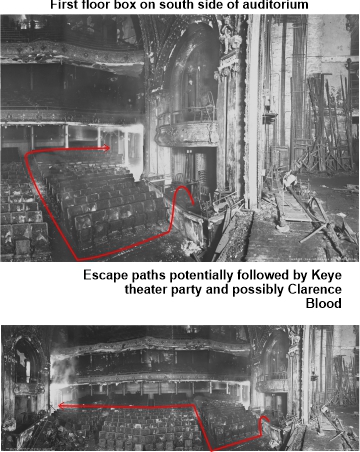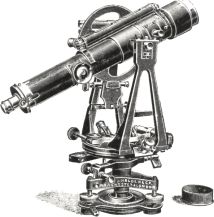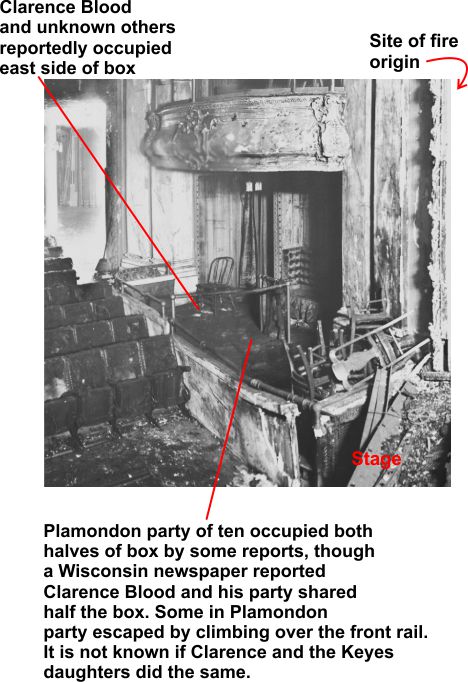|
Twenty-six-year-old civil
engineer Clarence C. Blood (1877-1919) reportedly
shared a first-floor box seat on the south side of
the Iroquois Theater.* In a lengthy newspaper
interview, a young woman in the
Keyes theater party of ten gave a detailed description
of what she and her companions experienced in that
same box (see link below). According to her, her
party occupied both halves of the box. The newspaper
story about Clarence Blood's seating and activities
at the Iroquois, on the other hand, came from his
father in Appleton, Fred H. Blood, a week after the
fire. My best guess is that when proud father Fred
and the Appleton reporter were shy of details, they
speculated about what happened. In their
imaginations, Clarence was quite the hero.
The fire broke out within twenty feet of the
box seat. The Keyes party, comprised of young women
from wealthy Chicago families, remained seated for
much longer than I would have. By the time they
exited, they had to brush flaming shards from their
hair and clothing. Newspaper stories in Clarence
Blood's hometown told of their local hero grabbing
two "little" girls from the box, daughters of an
Evanston banker, one under each arm. With "Herculean
strength and as if prompted by providential
dictation..." "remained unswerved in his giant-like
efforts and after several minutes of nearly
superhuman fighting, managed to get to the
street." Reportedly Clarence then incurred a gash on
the back of his head from a falling beam, became
semi-conscious, was taken to a hospital and given
restoratives until he regained consciousness.
The story of Clarence's heroism is as
problematic as the location of his seat. The "little
girls" in the box were aged 16, 16, 19, 19, 20, 21,
21, 22, 25 and 48. The Keyes daughters, who best fit
the description of his distressed damsels, were aged
16 and 25.† According to age/weight tables for women
of that period, each would have weighed 90-152 lbs.
Clarence did not hoist a minimum of two hundred
pounds and maneuver a distance of sixty to seventy
feet through a frenzied crowd. Perhaps he instead
put his arms around the girls and steered them
toward the exit. That's believable but if his arms
were around them, how did he push others aside to
clear a path? With his head? Maybe. Since his was
the only story of a falling beam at the Iroquois,
I'm more than a little inclined to discount it but a
fabricated head gash seems unlikely, perhaps an
angry theater goer carrying an umbrella brought it
down on his head. That scenario works for me.
It is telling that nothing about Clarence
being at the Iroquois appeared in newspapers outside
Wisconsin. Chicago newspapers did not mention his
heroism, injury or presence at the fire. Their lists
of severely injured did not include Clarence.
Escape paths
According to
a newspaper interview with one of the young women in
the party, Charlotte E. Plamondon, she and a
companion, Magdalen Elsie Elmore, ignored flaming
fabric to climb over the front brass rail (see
accompanying photo at right). They ran north between
the first row of seating and the orchestra pit,
turned east up an aisle, south toward the auditorium
exits (door
nos. 6-8), and made their way through the crush
into the main hall and eventually made it out the
front entrance. (See illustration below suggesting
the congestion that awaited in the main hall.)
They rejected the shorter escape route
through the curtained exit at the back of the box,
though it was the way they'd entered, thus the most
familiar route for them to have taken. It led to a
short flight of stairs and reached the same location
in the auditorium as their circuitous path. That
suggests the passage behind the box was filled with
smoke and/or flames.
Others in the Keyes party, including Clarence
Blood, may have taken the same path or may instead
have crossed the auditorium and exited through the
fire escape exits (door nos. 2-4) on the north side
of the structure, out onto Couch Place alley. The
button shoes, belt buckle, jewelry or teeth of a
victim jumping or falling from a second-floor
balcony or fire escape could have gashed his head.
That makes a Couch Place exit most likely. There
were many more falling bodies there than inside the
auditorium.
Clarence Curtice Blood Bio
Clarence had been married to Jeanette / Jane Adele Koch
(1879-1939) for over two years. In December 1903,
she was only three weeks away from giving birth to
their first and only child, Clarence Blood Jr.
(1904-1945). In December 1903, Jeanette remained at
their home in Iowa, her parents nearby, while
Clarence traveled to Chicago for an unknown reason,
presumably connected to his occupation.
During summers while in college and following
his graduation from the University of Wisconsin in
Madison, Clarence worked as a civil engineer on
railways, in 1898 going to work for the Chicago
and Northwestern Railroad (CNW) in Iowa,
reporting to
Hiram J. Slifer.‡

|

|
Clarence worked his way up in
railroad civil engineering from draftsman to
surveying supervisor. In 1900 he led a surveying
crew to investigate a Wisconsin railway line between
Merrill and Antigo.
Clarence retained strong ties to his boyhood home in
Appleton, Wisconsin
 through his parents — hardware store retailer Fred
H. Blood and Lillian Curtice Blood — and three
siblings. Fred Blood was, in 1902, the earliest
Appleton, WI settler still living, having arrived
there as an infant with his parents in 1848 after
leaving his birthplace, Green Bay, WI. Before
entering the hardware and lumber industry, Fred
worked as a train conductor and coal dealer, serving
as engineer on some of the first trains in Appleton.
During his last decades, he kept the Appleton
newspaper well apprised of his activities and those
of his family.
through his parents — hardware store retailer Fred
H. Blood and Lillian Curtice Blood — and three
siblings. Fred Blood was, in 1902, the earliest
Appleton, WI settler still living, having arrived
there as an infant with his parents in 1848 after
leaving his birthplace, Green Bay, WI. Before
entering the hardware and lumber industry, Fred
worked as a train conductor and coal dealer, serving
as engineer on some of the first trains in Appleton.
During his last decades, he kept the Appleton
newspaper well apprised of his activities and those
of his family.
In the years after the fire
In 1905 Clarence and his family moved to St. Paul, Minnesota, where he worked in engineering for Northern Pacific Railway. By 1907 the family lived in Seattle, where they would remain, excepting a short while in Portland, Oregon with the Portland, Eugene & Eastern Railway (PE&E) in 1913. He occasionally went by a spelling variation of his middle name - Curtis C. Blood. (This may have been to avoid confusion with another man in the railroad industry named Clarence Blood. Clarence A. Blood, sometimes identified as Clarence H. Blood, was from Lehigh Pennsylvania, in 1911 accused of engaging in questionable trade practices.) Later in 1913, Clarence left civil engineering and became roadmaster for the Northern Pacific yard in Puget Sound, Seattle, Washington. (A roadmaster is part of a
railroads "maintenance of way" system, maintaining track in a given
division.)


|
|
Discrepancies and addendum
* Augustus Eddy and Carroll L. Shaffer, the brother
and friend of two members of the Keyes party,
Josephine and Elizabeth Eddy, occupied row seats a
few feet from the box. Shaffer was the son of
prominent newspaper and railroad man, John
C. Shaffer.
Though a few years older than Shaffer, from a less
moneyed family and a graduate of a Midwestern
university rather than Yale, Clarence Blood did work
for a railroad. My newspaper searches looking for a
connection between Clarence and Shaffer or Eddy were
unproductive. However, Clarence almost certainly
attended the theater with companions and I've failed
to learn who they might have been. Augustus Eddy
tried to reach his sisters in the box but was swept
forward by the surging crowd. Perhaps the Keyes
theater party originally numbered thirteen. The ten
women filled the loge so the males — Eddy, Shaffer
and, perhaps, Clarence — took nearby row seats. Eddy
and Shaffer were swept toward the exits while
Clarence battled his way to the box.
† Charlotte Plamondon's father, Charles Plamondon,
was an officer in a bank but the family did not live
in Evanston, nor did Elsie Elmore, the girl who
escaped the theater with Charlotte. Charlotte
described having jumped into the arms of a man when
she climbed over the box rail. She later guessed he
might have been an employee of the theater, stating
that he set her down in a row seat and told her to
remain there for a moment. Had that man been
Clarence, presumably she would not have described
him as a theater employee. (Will
J. Davis Jr. is a possibility. He was at
the theater when the fire broke out but newspapers
published nothing of his actions that afternoon.)
‡ Slifer attended Clarence Blood's wedding in 1901.
The same year that Clarence Blood died, 1919, Slifer
would also lose his life. The sixty-two-year-old
lieutenant colonel in the Corps of Engineers in
France during World War I, overseeing rail
construction for the 1st Army during the St. Mihiel
and Argonne-Meuse offensives, received a posthumous
Army Distinguished Service Medal. I found no
evidence that Clarence joined his mentor in World
War I.
|
